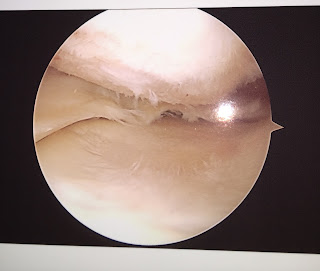Facts About Arthritis of the Knee
A 15 year study of middled aged (avg 53 years) of normal body weight (BMI avg 25) from the United Kingdom provides insight on the incidence and severity of symptomatic Knee OsteoArthritis.
These data are gender specific and since this is a normal weight population can not be extrapolated to the obese population. The annual rate at which middle-age women develop knee osteoarthritis (OA) is fairly low, but progression is common when x-ray changes in the joint are already present, a community-based cohort study found.
During 15 years of follow-up there is a 49% lifetime risk of developing symptomatic (not necessarily severe OA of the knee). 51% of normal weight women never develop knee arthritis.
Among the entire cohort, 561 had undergone knee radiography at baseline and then at years 5, 10, and 15.
High body mass index also was associated with an increased incidence, with a nearly 20% greater incidence by year 10 among obese women.
At 15 year followup nearly 30 % of those women with knee arthritis had the disease in both knees. 70 % had symptomatic arthritis in only one knee.
The rate of total knee replacement by year 15 was about 10 %.
The also know risk factors in order of significance are genetics, obesity, female gender, serious knee injury (bone or ligament or meniscus).
Knee Osteoarthritis Treatment Options – AUC from AAOS A Guide
- The new appropriate use criteria (AUC) on nonarthroplasty treatment of patients with OA of the knee covers 10 different treatment options and more than 500 patient scenarios.
- A web-based application (www.aaos.org/aucapp) enables clinicians to submit a patient profile based on specific clinical findings and receive feedback on the appropriateness of various treatment options.
- Although the AUC addresses the most common clinical scenarios, it does not include all of the possible indications, and is not meant to supersede clinician expertise and experience or patient preference.
Viscosupplementation for Knee Arthritis
 |
| OA is the death of the articular cartilage cells that cover the bone. |
Here is a summary of the recent literature review:
Hyaluronic acid has little effect on pain, none on function, new review states
Tuesday, June 12, 2012
If the first series of injections help then it is likely a repeat series will be successful. Not all insurers reimburse for this medication – so many patients pay out of pocket for the drug and come to the office for the doctor to inject the drug into their knee.
Another unknown is how and why this medication decreases pain – the mechanism is not clear at this time.
Diet + Exercise Effective
Report in JAMA September 25, 2013 (Journal of the American Medical Association) concludes Diet and Exercise is Effective in Improving quality of life (diminishing symptoms of pain, improving function/mobility) compared to exercise alone in overweight and obese patients with Osteoarthritis of the knee. Weight loss was greater in the Diet/Exercise group (11 %) compared to Exercise group (2%).
Details: According to a study published in the Sept. 25 issue of JAMA, diet and exercise may improve quality of life more than exercise alone for overweight and obese adults with knee osteoarthritis (OA). The authors conducted a randomized, single-blind trial of 399 patients who were allocated to one of three groups: diet, exercise, and diet plus exercise. At 18-month follow-up, the authors found that mean weight loss was 11.4 percent for participants in the diet plus exercise cohort, 9.5 percent in the diet group, and 2.0 percent in the exercise group. In addition, knee compressive forces were lower in diet participants compared with exercise participants, and concentrations of IL-6 were lower in diet plus exercise and diet participants compared against exercise participants. Finally, patients in the diet plus exercise group had less pain and better function than those in the diet group or the exercise group, and the diet plus exercise group had better physical health-related quality of life scores than those in the exercise group.
Link to Abstract – https://jama.jamanetwork.com/article.aspx?articleid=1741824.
Dr. T Speaks —– Hello People. There are simple measure that are dramatically effective in helping you treat yourself with medications, injections, or surgery. Make the effort to convert America into a healthier place. This is an easy way to treat a common problem that is effective and will lower health care costs. Take ownership of your own well being.
Physical Activity
Research suggesting that physical activity could help prevent Knee Osteoarthritis has been presented this week at the AVS 62nd International Symposium and Exhibition, in San Jose, CA.
Researchers including Dr. Burris at the University of Delaware found that as the sliding speed increased toward typical walking speeds cartilage thinning was reversed. At slow sliding speeds (less than would occur in a joint at typical walking speeds) cartilage thinning and an increase in friction occurred over time. This may explain why walking or cycling can mitigate knee pain in patients with osteoarthritis of the knee.
A healthy joint surface is composed of 80 % synovial fluid (water and proteins). To investigate whether hydrodynamic pressurization could refill deflated cartilage, the researchers placed larger-than-average cartilage samples against a glass flat to ensure that there would be a wedge. Pressure forced fluid back into the articular cartilage stopping the joint surface from deflating. If movement occurs faster than the fluid can diffuse then continuous knee movement could prevent deflation.
 Articular Cartilage is a firm, porous, rubbery material covering the ends of the bones in the knee joint. It reduces friction in the joint and acts as a “shock absorber.” Loss of synovial fluid occurs when articular cartilage is damaged or diseased. Osteoarthritis is a degenerative disease resulting from a reduction in the articular cartilage thickness, leading to an increase in friction, inflammation, pain and deformity of legs.
Articular Cartilage is a firm, porous, rubbery material covering the ends of the bones in the knee joint. It reduces friction in the joint and acts as a “shock absorber.” Loss of synovial fluid occurs when articular cartilage is damaged or diseased. Osteoarthritis is a degenerative disease resulting from a reduction in the articular cartilage thickness, leading to an increase in friction, inflammation, pain and deformity of legs.
When cartilage becomes damaged or deteriorates, it limits the knee’s normal movement and can cause significant pain, and eventually the need for knee replacement surgery.
| Surface damage to articular cartilage in a knee |
Knee Braces
Non Operative Treatment of Knee Pain/Arthritis with BracingAdvanced Knee Care offers a custom bracing service to patients. This service includes a brief physician visit to confirm the diagnosis and need for the brace, a confirmatory x-ray of the knee and a detailed visit with our bracing specialist, Megan. The charge for this screening visit is $50 (insurance will be billed, if applicable).
The concept for this service is that there are many people that can be treated without surgery. A knee brace may be just what is needed to keep one active for years—no surgery required. This treatment is for people with Knee Pain and Knee Arthritis (either in the main joint or in the patellofemoral joint) that do not want a complex or expensive work up by the doctor, have already tried the myriad of other options for knee arthritis (pills, injections, Physical Therapy, Arthroscopic Surgery) and want a streamlined way to purchase a knee brace to help improve their knee function, help them be more active, and help them exercise to stay fit. There are also good bracing applications for runners with knee pain.
Treat Depression
A Korean study published in March, 2011 concludes that depression is linked to knee arthritis symptoms. The authors evaluated 660 patients aged 65 years or older; severity of knee OA was assessed based on radiographs and symptoms and depression was assessed based on interviews and patient questionnaires. The presence of a depressive disorder was associated with increased risk of symptomatic knee OA among patients with a radiographic severity of minimal to moderate OA.
Mental well being and a positive outlook help people cope with and tolerate symptoms of disease. In this study, a person with minimal to moderate Knee Osteoarthritis was more likely to have moderate to severe symptoms, and the reason for the increased dysfunction was thought to be due to poor mental health, not poor physical health.
This is a good lesson for both patients and doctors. Always consider a person’s overall health when formulating treatment plans. In some cases treatment should be directed at the cause of symptoms (treat depression, not knee arthritis) for the best outcome.

Dr. Tarlow is the only Orthopedic Surgeon to limit his practice to encompass Adult Reconstruction and Sports Medicine for the diagnosis and treatment of knees. Dr. Tarlow’s practice focuses on excelling in the art of Knee Diagnosis and Surgery. He performs the full spectrum of Knee Surgery from Knee Arthroscopy, ACL Reconstruction, Patellar Stabilization and Cartilage Restoration to Makoplasty Partial Knee Replacement to Total Knee Replacement to Revision Total Knee Replacement. His focus is exceptional customer service and he endeavors to exceed the diverse expectations of his patients.


Leave a Reply